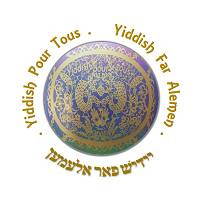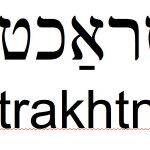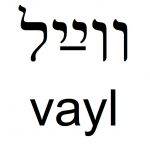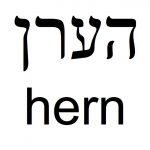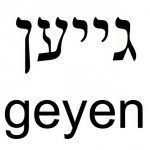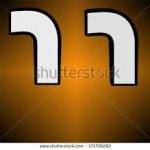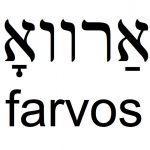Aujourd’hui, comme chaque jour, nous ajoutons 5 nouveaux mots à notre vocabulaire.
Nous voici à 30, et avec les quelques notions de grammaire, nous savons déjà construire quantité de phrases élémentaires.
Encore un petit mot interrogatif, une conjonction de coordination et 3 verbes.
Nous continuons aussi à apprendre la conjugaison des verbes.
Today, like every day, we add 5 new words to our vocabulary.
Here we are at 30, and with a few notions of grammar, we already know how to build a lot of elementary sentences.
Another interrogative word, a conjunction of coordination and 3 verbs.
We also continue to learn the conjugation of verbs.
POURQUOI? = WHY? = FARVOS?, FAR VOS? = פֿאַרװאָס?פֿאַר װאָס
CAR = BECAUSE = VAYL = װײַל
ALLER = TO GO = GEY/EN = גײען
ENTENDRE, ECOUTER = TO HEAR, TO LISTEN = HER/N = הערן
PENSER = TO THINK = TRAKHT/N = טראַכטן
FARVOS peut s’écrire indifféremment en un ou deux mots.
Dans GEY/EN, nous voyons à nouveau un E (ע Ayin) s’intercaler entre le radical et la finale. Il en est toujours ainsi quand le radical se termine par une diphtongue.
FARVOS can be written in one or two words.
In GEY / EN, we see again an E (ע Ayin) between the radical and the final. It is always so when the radical ends with a diphthong.
NOUS ENTENDONS = WE HEAR = MIR HER/N = מיר הערן
ILS, ELLES ENTENDENT = THEY HEAR = ZEY HER/N = זײ הערן
NOUS ALLONS = WE GO = MIR GEY/EN = מיר גײען
ILS, ELLES VONT = THEY GO = THEY GEY/EN = זײ גײען
NOUS PENSONS = WE THINK = MIR TRAKHT/N = מיר טראַכטן
ILS, ELLES PENSENT = THEY THINK = ZEY TRAKHT/N = זײ טראַכטן
Nous voyons donc qu’à la première et à la troisième personne du pluriel, le verbe à exactement la même forme qu’à l’infinif. Simple!
Exercez-vous à conjuguer tous les verbes que nous connaissons aux 5 personnes que nous avons apprises (Il ne nous manque plus que la deuxième personne du singulier et nous aurons fait le tour de la conjugaison des verbes au présent de l’indicatif).
We can see that in the first and third person of the plural, the verb has exactly the same form as in the infinitive. Simple!
Practice conjugating all the verbs we know at the 5 persons we have learned (We only miss the second person singular and we will have gone around the conjugation of verbs in the present indicative).
Ne vous affolez pas avec l’écriture hébraïque. Nous n’avons pas encore fait le tour complet des lettres. Il est donc normal que vous n’arriviez pas encore à tout déchiffrer. Cela viendra petit à petit.
Aujourd’hui, je voudrais attirer votre attention sur la manière dont le yiddish forme les diphtongues EY et AY.
On utilise 2 Yud pour faire EY et 2 Yud soulignés (le trait s’appelle un “pasekh”) pour faire le son AY.
Pour une explication détaillée voir le post de Regine Bloch-Fiderer ici:
https://www.facebook.com/groups/YiddishPourLesNuls/permalink/509947009187682/
Do not panic with Hebrew writing. We have not studied all the letters yet. It is therefore normal that you still can decipher everything. It will come little by little.
Today, I would like to draw your attention to how Yiddish forms EY and AY diphthongs.
We use 2 Yud to make EY and 2 Yud underlined (the line is called a “pasekh”) to make the sound AY.
For a detailed explanation see Regine Bloch-Fiderer’s post here:
https://www.facebook.com/groups/YiddishPourLesNuls/permalink/509947009187682/
Voici le fichier audio de la leçon/ Here is the audio fil of the lesson
https://soundcloud.com/user-369999034/yiddish-lecon-6
